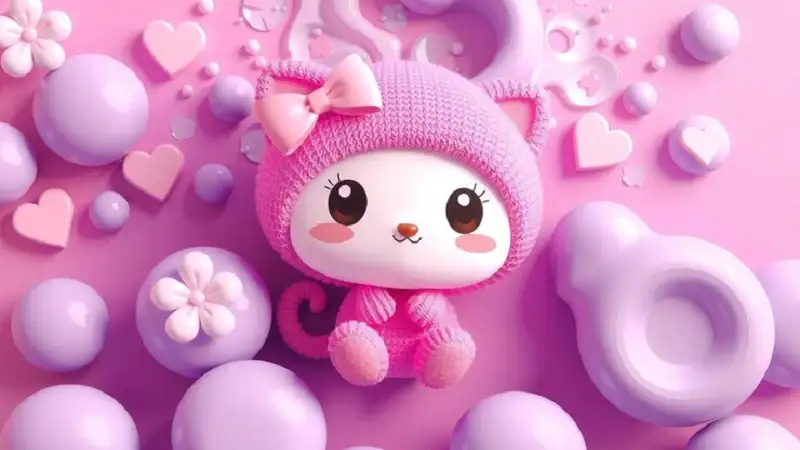Sanrio:8nwrku8x2lo= Hello Kitty is more than just a cute face on stationery, backpacks, and accessories; she’s a cultural icon with a story that stretches across decades. This friendly character created by Sanrio has an enormous fan base that spans generations and countries. Let’s take a journey through Hello Kitty’s origin, impact, and future.
What is Hello Kitty?
Sanrio:8nwrku8x2lo= Hello Kitty is a character created by the Japanese company Sanrio in 1974. She’s known for her simple design—white fur, a red bow on her left ear, and no mouth. Despite her minimalist look, she has charmed the world and created an empire that includes everything from toys to theme parks.
Brief Overview of the Character
Hello Kitty’s full name is Kitty White, and she’s depicted as a little girl, not a cat, despite her feline appearance. Sanrio describes her as a cheerful and kind-hearted individual who lives in London with her parents and twin sister.
Hello Kitty’s Distinctive Features
One of the most notable features of Sanrio:8nwrku8x2lo= Hello Kitty is her lack of a mouth. This choice was deliberate, as it allows people to project their emotions onto her face. Whether you’re happy or sad, Hello Kitty can “share” your feelings.
The Origins of Hello Kitty
Sanrio’s Creation of Hello Kitty
Sanrio was originally a company that sold small gift items, often adorned with cute characters. The idea was to create something that could represent happiness and friendship. Hello Kitty was born from this vision, and her first appearance was on a vinyl coin purse in 1974.
First Appearance in 1974
The initial sketch of Hello Kitty featured her sitting on a pile of grass with a milk bottle by her side. Although the design has evolved, her core features remain the same. She quickly became Sanrio’s flagship character.
The Brand Behind Hello Kitty
Sanrio’s History and Vision
Sanrio:8nwrku8x2lo= Hello Kitty started as a company focusing on creating products that could foster happiness in daily life. The philosophy of “small gift, big smile” perfectly encapsulates the purpose behind characters like Hello Kitty. Sanrio believes that a small token, like a Hello Kitty keychain, can bring joy.
Sanrio’s Beginning
Founded in 1960 by Shintaro Tsuji, Sanrio originally sold silk. Tsuji shifted the company’s focus to creating playful, adorable products that spread happiness, with Hello Kitty becoming their top mascot.
The Evolution of Hello Kitty’s Design
Changes Over the Years
Over the years, Hello Kitty’s design has undergone subtle changes. Her bow and clothing colors vary across merchandise, and her shape has become slightly rounder and more polished.
H3: Why Hello Kitty Has No Mouth
The decision to leave Hello Kitty without a mouth was intentional. Sanrio explained that this helps people connect with the character emotionally, as her expression remains neutral, allowing for a wide range of interpretations.
Hello Kitty’s Cultural Impact
Global Popularity
Sanrio:8nwrku8x2lo= Hello Kitty appeal is global, transcending language and cultural barriers. In Japan, she’s a symbol of the kawaii (cute) culture, but her influence has spread to Europe, the U.S., and beyond.
Success in Japan and Worldwide
In the decades since her debut, Hello Kitty has generated billions in sales, thanks to her presence on a wide range of products, from school supplies to luxury items.
Hello Kitty in Fashion
Hello Kitty’s design has made her a fashion icon. Her collaboration with high-end designers like Yohji Yamamoto and brands like Puma has elevated her from a cute character to a symbol of chic.
Clothing, Accessories, and Collectibles
Hello Kitty’s face has graced designer clothing lines, handbags, and even makeup collections, appealing to both children and adults.
Hello Kitty’s Place in Pop Culture
Celebrities and Hello Kitty
Celebrities like Lady Gaga and Katy Perry have publicly expressed their love for Hello Kitty. Lady Gaga even wore a Hello Kitty-themed outfit in one of her music videos.
Hello Kitty and Subcultures
Kawaii Culture
Sanrio:8nwrku8x2lo= Hello Kitty is a huge part of Japan’s kawaii (cute) culture. This trend values all things sweet, innocent, and adorable, with Hello Kitty serving as one of its most prominent ambassadors.
Conclusion:
Sanrio:8nwrku8x2lo= Hello Kitty has come a long way from her humble beginnings in Japan to becoming a global cultural phenomenon. Her simple yet adaptable design, along with her ability to connect emotionally with people, makes her one of the most beloved characters ever created.
